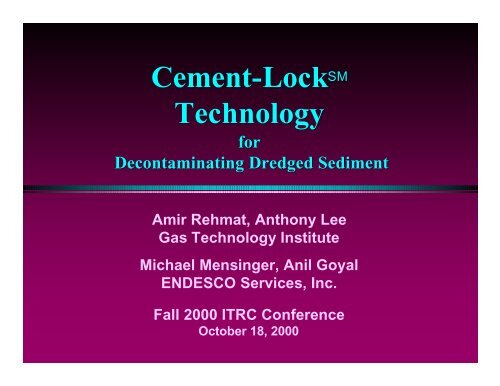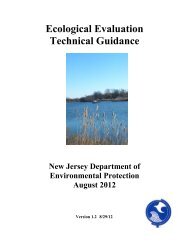sediment - ITRC
sediment - ITRC
sediment - ITRC
Create successful ePaper yourself
Turn your PDF publications into a flip-book with our unique Google optimized e-Paper software.
Cement-Lock SM<br />
Technology<br />
for<br />
Decontaminating Dredged Sediment<br />
Amir Rehmat, Anthony Lee<br />
Gas Technology Institute<br />
Michael Mensinger, Anil Goyal<br />
ENDESCO Services, Inc.<br />
Fall 2000 <strong>ITRC</strong> Conference<br />
October 18, 2000
Cement-Lock SM<br />
Technology<br />
An advanced thermo-chemical manufacturing<br />
process for decontaminating dredged<br />
<strong>sediment</strong>s, soils, wastes, and sludges and<br />
transforming these wastes into resources:<br />
● Sediment is transformed into constructiongrade<br />
cement<br />
● Organic contaminants are destroyed with<br />
DRE’s > 99%<br />
● Heavy metals are immobilized in the cement<br />
matrix
Cement-Lock SM Technology<br />
Description<br />
STEAM<br />
SEDIMENT<br />
FUEL<br />
AIR/O 2<br />
MODIFIERS<br />
ECOMELT<br />
GENERATOR<br />
2400° - 2600°F<br />
SECONDARY<br />
COMBUSTION<br />
ADDITIVE<br />
HEAT<br />
RECOVERY<br />
GAS<br />
CLEAN<br />
UP<br />
CLEAN<br />
FLUE<br />
GAS<br />
ECOMELT<br />
QUENCH<br />
PULVERIZER/<br />
MIXER<br />
High Quality<br />
CONSTRUCTION-<br />
GRADE CEMENT
Cement-Lock SM<br />
Technology Supporters<br />
● U.S. EPA Region 2<br />
● Brookhaven National Laboratory<br />
● U.S. Army Corps of Engineers<br />
● U.S. EPA Region 5 / GLNPO<br />
● MI Dept. of Env. Quality<br />
● NJ Office of Maritime Resources<br />
● NJ Dept. of Transportation<br />
● GRI<br />
● Unitel Technologies, Inc.<br />
● Private Corporations
Cement-Lock SM Technology<br />
Applications<br />
● Harbor & river <strong>sediment</strong>s<br />
● MGP site soils<br />
● Brownfield soils, debris<br />
● Superfund site soils<br />
● Military BRAC wastes, debris<br />
● Municipal solid wastes & sludges<br />
● Petroleum sludges<br />
● Tank / tanker bottoms<br />
● Spent molecular sieves, etc.<br />
● Coal ash, etc.
Cement-Lock SM Technology<br />
-- Wastes Tested<br />
● Dredged estuarine <strong>sediment</strong>s<br />
● Dredged river <strong>sediment</strong>s<br />
● Municipal solid waste<br />
● MSW incinerator ash<br />
● Contaminated concrete<br />
● Coal fly ash<br />
● Coal bottom ash<br />
● Oil-contaminated soil<br />
● PCB-contaminated soils<br />
● U-containing wastes
Technology Development<br />
Status for Dredged Sediment<br />
● Bench-scale data with Newtown Creek<br />
(NY) <strong>sediment</strong> - WRDA (COE/EPA2/BNL)<br />
and Black Lagoon (Detroit River) <strong>sediment</strong><br />
- MI-DEQ<br />
● Pilot-scale (1-ton/day) data with Newtown<br />
Creek <strong>sediment</strong> and contaminated soil -<br />
WRDA (COE/EPA2/BNL), private sector<br />
● Demo plant (30,000-150,000 cy) for<br />
dredged <strong>sediment</strong> currently under<br />
construction for NJ - WRDA<br />
(COE/EPA2/BNL), NJ-MR, private sector
Technology Development<br />
Status for Dredged Sediment<br />
● Demo plant (2,000 - 5,000 cy) for Black<br />
Lagoon (Detroit River) <strong>sediment</strong> - EPA5,<br />
GLNPO, MI-DEQ, private sector<br />
● Engineering completed for 100,000 cy/yr<br />
plant module and 500,000 cy/yr plant<br />
● Cost for complete dredged <strong>sediment</strong>-tocement<br />
production plant (1 module of<br />
100,000 cy/yr capacity) is $20 million.
Independent Data<br />
Verification<br />
● Organic Contaminant<br />
Destruction<br />
– Triangle Laboratories,<br />
Durham, NC<br />
● Metals Immobilization<br />
– Triangle Laboratories,<br />
Durham, NC<br />
● Air Sampling Data<br />
– AirNova, Pennsauken, NJ
Cement-Lock SM is Very Effective in<br />
Destroying Organic Contaminants<br />
Contaminant<br />
------ Estuarine Sediment ------ ---------- River Sediment ----------<br />
Untreated Cement<br />
Untreated Cement<br />
Sediment Product Destruction Sediment Product Destruction<br />
----- mg/kg (dry) ----- --%-- ----- mg/kg (dry) ----- --%--<br />
Oil & Grease - - - - - - 18,000 < D.L.* > 99.99<br />
PAHs 370 0.22 99.93 51.2 < D.L. 99.99<br />
------ m g/kg (dry) ----- ------ m g/kg (dry) ------<br />
PCBs 8,585 < D.L. > 99.99 1,100 < D.L. > 99.99<br />
----- ng/kg(dry) -----<br />
Dioxins/Furans<br />
2,3,7,8 TCDD/F 262 < D.L. > 99.99<br />
Other TCDD/F 2,871 < D.L. > 99.99<br />
PeCDD/F 4,363 < D.L. > 99.99<br />
Hx/Hp/OCDD/F 34,252 < D.L. > 99.99<br />
* Below the analytical method detection limit.
Cement-Lock SM is Very Effective in<br />
Immobilizing Inorganic Contaminants<br />
Metal<br />
Untreated Material<br />
Estuarine<br />
Sediment<br />
River<br />
Sediment<br />
Toxicity Characteristic Leaching Procedure<br />
Cement Produced From<br />
Estuarine River Regulatory<br />
Sediment Sediment Limit<br />
------ mg/kg (dry) ------ -------------------- mg/L --------------------<br />
Arsenic 39 7.8 < 0.005* < 0.01 5<br />
Cadmium 27 9.5 < 0.001 < 0.002 1<br />
Chromium 298 138 0.15 < 0.072 5<br />
Copper -- 180 -- < 0.01 --<br />
Lead 542 218 < 0.002 < 0.01 5<br />
Mercury 2.9 0.55 < 0.0004 < 0.0004 0.2<br />
Selenium 6.2 -- < 0.003 -- 1<br />
Silver 13 -- < 0.001 -- 5<br />
* Analytical method detection limit.
Cement-Lock SM Pilot-Scale Unit
Ecomelt<br />
produced during<br />
pilot-scale<br />
testing
Cement-Lock SM Technology<br />
Pilot-Scale Air Emissions<br />
Flue Gas Composition*<br />
Outlet<br />
CO2, mol % 8.1<br />
CO, ppm 25<br />
HCl, ppm 14.2<br />
NOx, ppm 67.7<br />
SO 2 , ppm 44.1<br />
Total Hydrocarbons, ppm 10.6<br />
PCBs<br />
< 1.1 x10 -6 lb/hr<br />
Pesticides < 2.8 x 10 -7<br />
Chlorobenzenes/Chlorophenols < 6.8 x 10 -5<br />
SVOCs<br />
BDL**<br />
Total 2,3,7,8-CDDs (TEF) < 4.0 x 10 -12<br />
Total 2,3,7,8-CDFs (TEF) < 8.1 x 10 -12<br />
Particulates, grains/dscf < 2.0 x 10 -4<br />
Particulate Phase Composition<br />
PCBs < 5.3 x 10 -7<br />
Total 2,3,7,8-CDDs (TEF) < 8.0x10 -12<br />
Total 2,3,7,8-CDFs (TEF) < 7.3x10 -13<br />
___________________________<br />
* Adjusted to 7% oxygen<br />
** Below detection limit, some phthalate compounds detected
Cement Certification<br />
& Testing<br />
● Construction Technology Laboratories,<br />
Inc. (CTL, Skokie, IL, subsidiary of<br />
Portland Cement Association)<br />
● Prairie Cement Group (Chicago, IL, cement<br />
manufacturer)<br />
● New Jersey Department of Transportation<br />
(NJ-DOT, public project applications)<br />
● Sor Testing Laboratories (Cedar Grove,<br />
NJ, cement/concrete testing services for<br />
NJ/NY area)
Compressive Strength of Cement<br />
from Sediment and Debris<br />
Compressive Strength, psi<br />
6000<br />
5000<br />
4000<br />
3000<br />
2000<br />
1000<br />
3 Days 7 Days 28 Days<br />
28-day portland cement<br />
requirement: 4060 psi<br />
0<br />
Estuarine Sediment River Sediment Concrete Debris<br />
Feedstock
Compressive Strength of<br />
Cement from Ash<br />
Compressive Strength, psi<br />
6000<br />
5000<br />
4000<br />
3000<br />
2000<br />
1000<br />
0<br />
3 Days 7 Days 28 Days 28-day portland cement<br />
requirement: 4060 psi<br />
CF1* CF2* CF3* CB1* CB2* CB3* MSW1**<br />
Formulations<br />
*Cement made from grinding various formulations of Ecomelt with 75 wt% additives.<br />
**Cement made from grinding Ecomelt with 60 wt% additives.
Compressive Strength of Cement<br />
from Contaminated Soils<br />
Compressive Strenght, psi<br />
6000<br />
5000<br />
4000<br />
3000<br />
2000<br />
1000<br />
28-day portland cement<br />
requirement: 4060 psi<br />
3 Day 7 Day 28 Day<br />
0<br />
Petroleum<br />
Contaminated Soils<br />
Soils Contaminated<br />
with 9,100 ppm of PCB<br />
Equivalent<br />
MSW<br />
Feedstock
Comparison of Trace Elements in Cement-<br />
Lock SM Cement & Portland Cement<br />
Element<br />
Cement-Lock<br />
Cement<br />
Portland Cement*<br />
---------- Range ----------<br />
-------------------------- mg/kg --------------------------<br />
Mercury < 0.07** < 0.001 0.039<br />
Selenium < 0.94 0.62 2.23<br />
Cadmium 1.59 0.03 1.12<br />
Lead 35.8 1 75<br />
Silver 2.66 6.75 19.9<br />
Arsenic 9.22 5 71<br />
Barium -- 91 1402<br />
Chromium 196 25 422<br />
Nickel 133 15 129<br />
* Portland Cement Association, 1992<br />
** Below analytical detection limit
Factors Affecting<br />
Technology Performance<br />
Factor<br />
• Moisture content<br />
• Variations in type & quantity of<br />
organic contaminants<br />
• Variations in type & quantity of<br />
heavy metals<br />
• Sediment quality (clayey, loamy,<br />
sandy)<br />
• Sediment particle size<br />
Effect<br />
• No effect<br />
• No effect<br />
• No effect<br />
• No effect<br />
• No effect
Factors Affecting<br />
Technology Economics<br />
Factor<br />
• Moisture content<br />
• Non-steady supply<br />
• Use of alternate fuels<br />
(sewage sludge and/or<br />
refinery tank bottoms)<br />
• Non-continuous batch<br />
processing of <strong>sediment</strong><br />
aliquot<br />
Effect<br />
• Affects quantity of<br />
cement / revenues<br />
• Larger storage<br />
required - affects<br />
capital costs<br />
• Considerably reduces<br />
<strong>sediment</strong> treatment<br />
costs<br />
• Capital attributed to<br />
batch increases<br />
processing cost
Logistical & Regulatory<br />
Requirements<br />
● Permit requirements - similar to those<br />
for manufacturing process plants<br />
● Air permit required<br />
● Net water user - No process water<br />
discharge permit needed<br />
● Large-scale plant (>500,000 cy/yr)<br />
incorporates engineered transportation<br />
and logistics system so that dredged<br />
<strong>sediment</strong> is moved from the channel to<br />
the cement market seamlessly
Logistical & Regulatory<br />
Requirements<br />
● Small-scale plant (
Net Cost of Sediment<br />
Treatment - 3 Scenarios<br />
1. Dedicated 500,000 cy/yr <strong>sediment</strong> treatment<br />
facility; 20-year life span; fueled by natural<br />
gas; cement commanding the same price as<br />
portland cement.<br />
2. Dedicated 500,000 cy/yr <strong>sediment</strong> treatment<br />
facility; 20-year life span; fueled by sewage<br />
sludge and/or refinery tank bottoms;<br />
cement commanding the same price as<br />
portland cement.<br />
3. Case 2 except with cement commanding<br />
50% of the price of portland cement.
Unit Processing Costs for a<br />
500,000 yd 3 /year Capacity Plant<br />
Case 1 Case 2 Case 3<br />
Credits ---------------------- $1000’s ----------------------<br />
Sale of Cement ($70/ton) $17,440 $23,100 $11,550<br />
Tipping Fees From Other Wastes -- 18,810 18,810<br />
Total Credits $17,440 $41,910 $30,360<br />
Expenses<br />
Labor $930 $930 $930<br />
Raw Materials 3,470 4,035 4,035<br />
Utilities 12,110 6,055 6,055<br />
Maint./Misc. 5,775 5,775 5,775<br />
Total Expenses $22,285 $16,795 $16,795<br />
Provision for Lease $1,500 $1,500 $1,500<br />
Depreciation $10,500 $10,500 $10,500<br />
Net Processing Cost $16,845 ($13,115) $1,565<br />
Break-Even Tipping Fee, $/yd 3 $33.69 ($26.23) $3.13<br />
Case 1: 100% harbor <strong>sediment</strong> feed<br />
Case 2: 75% harbor <strong>sediment</strong> feed + 25% other waste feed<br />
Case 3: Case 2 except cement sale price reduced by 50%
Commercial Readiness<br />
● All equipment is commercially<br />
available<br />
● Vendors are willing to provide<br />
turnkey plants:<br />
– ABB, Svedala, Andersen 2000<br />
● Pilot plant data sufficient for<br />
detailed design and construction
Commercial Readiness<br />
● Modular plant construction<br />
– 100,000 cy/y modules<br />
– Modules can be added as needed<br />
● Additional environmental and cement<br />
utilization data will be generated at<br />
the NJ demo facility
Cement-Lock SM Technology<br />
-- Summary<br />
● Simple, one-step method for processing large<br />
volumes of <strong>sediment</strong>, soil, MSW, etc. with<br />
practically no restrictions on their content.<br />
● All processing equipment is commercially<br />
available.<br />
– No development required<br />
● Provides a permanent solution for disposing<br />
of dredged <strong>sediment</strong><br />
● Favorable economics<br />
– Tipping/processing fees<br />
– Finished product sales (ASTM quality<br />
construction-grade cement)<br />
– Industrial wastes co-processing
















